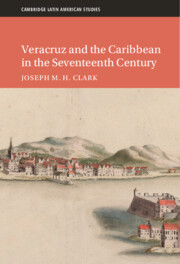Book contents
- Veracruz and the Caribbean in the Seventeenth Century
- CAMBRIDGE LATIN AMERICAN STUDIES
- Veracruz and the Caribbean in the Seventeenth Century
- Copyright page
- Dedication
- Contents
- Figures
- Maps
- Tables
- Acknowledgments
- Note on the Text
- Abbreviations
- Maps
- Introduction
- Part I Building the Mexican-Caribbean World
- 1 Veracruz Before the Caribbean
- 2 Environment, Health, and Race, 1599–1697
- 3 Imperial Designs and Regional Systems
- 4 The Large and Small-Scale Introduction of Africans to Veracruz
- Part II The Caribbean in Veracruz
- Appendices
- Bibliography
- Index
- Cambridge Latin American Studies
3 - Imperial Designs and Regional Systems
from Part I - Building the Mexican-Caribbean World
Published online by Cambridge University Press: 19 January 2023
- Veracruz and the Caribbean in the Seventeenth Century
- CAMBRIDGE LATIN AMERICAN STUDIES
- Veracruz and the Caribbean in the Seventeenth Century
- Copyright page
- Dedication
- Contents
- Figures
- Maps
- Tables
- Acknowledgments
- Note on the Text
- Abbreviations
- Maps
- Introduction
- Part I Building the Mexican-Caribbean World
- 1 Veracruz Before the Caribbean
- 2 Environment, Health, and Race, 1599–1697
- 3 Imperial Designs and Regional Systems
- 4 The Large and Small-Scale Introduction of Africans to Veracruz
- Part II The Caribbean in Veracruz
- Appendices
- Bibliography
- Index
- Cambridge Latin American Studies
Summary
Chapter 3 examines regional trade networks, drawing on archival records of import and export tax duties assessed in the ports of Veracruz, Havana, and Cartagena. Contrasting regional trade with transatlantic trade—which was larger than regional trade by volume and value and has thus occupied most scholarly attention—I show that ships moved between Veracruz and the Caribbean Islands and mainland littoral with greater frequency than they did between Veracruz and Europe. Shipping within the Mexican-Caribbean was also not entirely a byproduct of transatlantic trade, as we often imagine, but a distinct circuit following its own seasonal patterns. Focusing on seasonality and other “soft” factors, I argue that rather than seeing regional trade simply as a secondary consequence of transatlantic trade, we can see it as a primary means through which people in the Mexican-Caribbean world created material links to one another and participated in a common commercial system.
Keywords
- Type
- Chapter
- Information
- Veracruz and the Caribbean in the Seventeenth Century , pp. 74 - 105Publisher: Cambridge University PressPrint publication year: 2023

